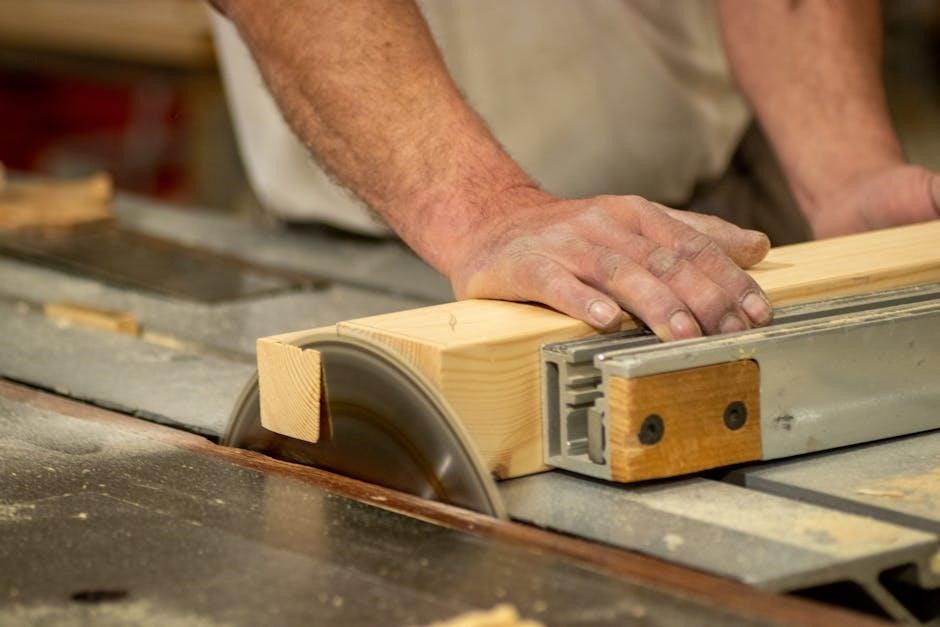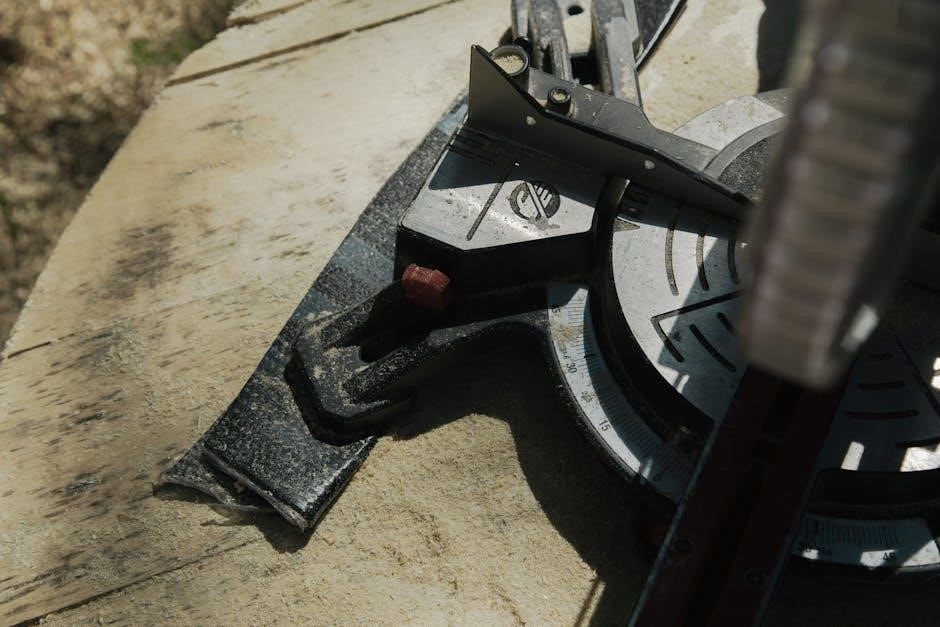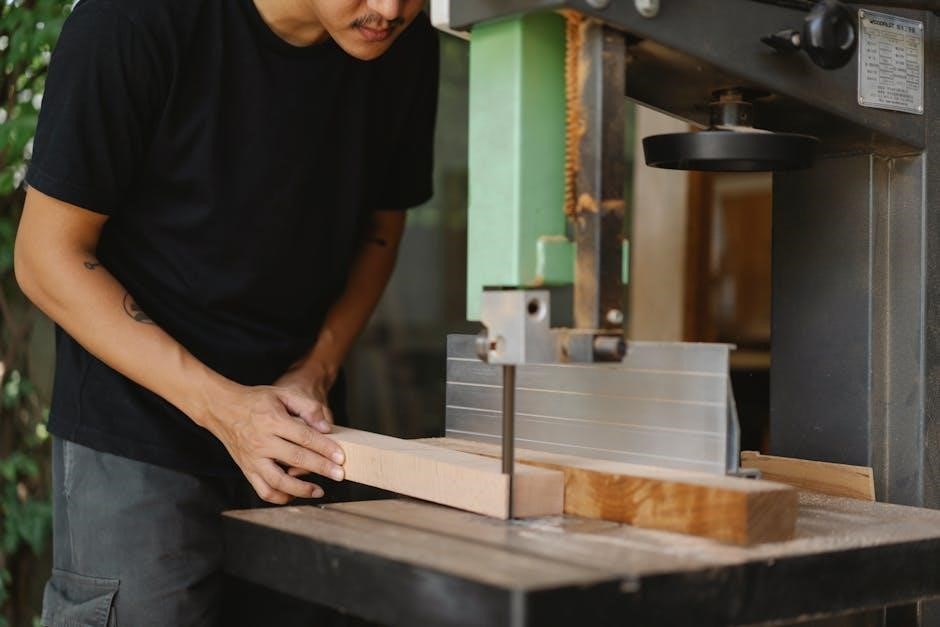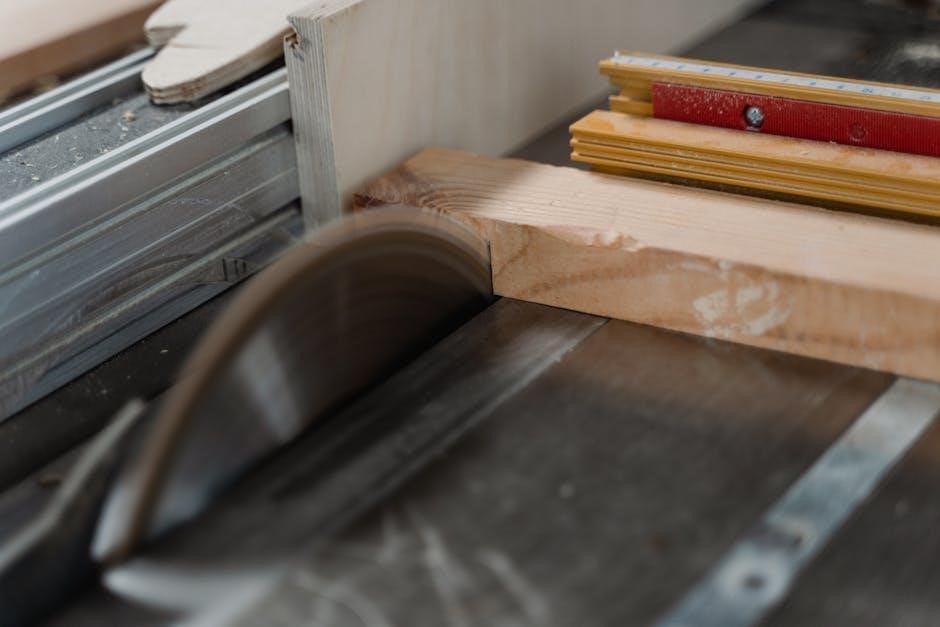Scroll saw blades come in various sizes and types, each designed for specific materials and tasks. Understanding blade size guides helps in achieving precise cuts and smooth finishes.
Importance of Choosing the Right Blade
Selecting the appropriate scroll saw blade is critical for achieving precise cuts and maintaining the quality of your work. The right blade ensures smooth, accurate results, while the wrong choice can lead to rough cuts, edge burning, or even blade breakage. Blades designed for specific materials and thicknesses optimize performance, reducing waste and improving efficiency. Proper blade selection also extends tool life and enhances project quality, making it essential for both beginners and experienced craftsmen. By matching the blade to the task, you ensure better control, cleaner finishes, and overall satisfaction with your woodworking projects.
Brief History of Scroll Saw Blades
The history of scroll saw blades dates back to the late 1800s, when scroll saws became popular for intricate woodworking. Early blades were simple, with limited tooth configurations and materials. Over time, advancements in metallurgy led to improved durability and precision. The introduction of spiral blades in the mid-20th century revolutionized the craft, enabling 360-degree cutting. Modern blades now feature specialized designs, such as skip and diamond-coated options, catering to diverse materials like wood, metal, and plastic. This evolution reflects the growing demand for versatility and efficiency in woodworking and other precision crafts, making scroll saw blades indispensable for detailed projects.

Understanding Scroll Saw Blade Sizes
Scroll saw blades are sized from 12 to 2/0 or 3/0, with higher numbers indicating thicker, wider blades and fewer teeth per inch for coarser cuts.
Numerical Sizing: What Do the Numbers Mean?
Numerical sizing for scroll saw blades ranges from 12 to 3/0, with larger numbers indicating thicker, wider blades. Higher numbers (e.g., 12) are for coarse cuts in thick materials, while lower numbers (e.g., 2/0) are for finer details. The numbering system helps determine the blade’s teeth per inch (TPI), which affects cutting precision and speed. Understanding this system ensures proper blade selection for optimal performance in various woodworking and crafting projects.
Blade Width and Thickness: Key Measurements
Blade width and thickness are critical factors in scroll sawing. Wider blades (e.g., 1/4 inch) are ideal for straight cuts and thicker materials, while narrower blades (e.g., 1/16 inch) excel in intricate designs. Thickness determines rigidity and resistance to bending, with thicker blades suited for dense materials. Proper measurements ensure precise control and prevent breakage, optimizing performance for various projects. Always match blade width and thickness to your material and design complexity for the best results.
Tooth Configuration: Types and Functions
Tooth configuration significantly impacts cutting efficiency and finish quality. Skip-tooth blades, with spaced teeth, offer fast cuts and smooth finishes, ideal for hardwoods. Standard blades provide balanced performance for general use, while spiral blades enable 360-degree cutting. Specialty blades, like those for jewelry, feature fine teeth for intricate details. Tooth count per inch (TPI) varies, with higher TPI (e.g., 28) suited for dense materials and lower TPI (e.g., 12) for softer woods. Understanding tooth types and their functions ensures optimal results for diverse projects, from delicate fretwork to robust cuts. Proper tooth configuration enhances precision and minimizes material waste, making it essential for achieving professional-grade finishes.

Materials and Applications
Scroll saw blades are versatile, cutting wood, metal, plastic, and more. Blade sizes vary to suit materials, from delicate jewelry to thick hardwoods, ensuring precise results.
Wood: Hardwoods, Softwoods, and Plywood
Scroll saw blades are essential for cutting various wood types, including hardwoods, softwoods, and plywood. Blade size guides recommend specific teeth per inch (TPI) and blade thickness for different wood densities. For hardwoods like maple or oak, higher TPI blades ensure smoother cuts, while softwoods like pine may require coarser blades for faster cutting. Plywood often needs blades with skip or spiral configurations to minimize tear-out. Proper blade selection enhances cutting efficiency and finish quality, making it crucial for woodworking projects. Using the right blade size ensures precise control and prevents material damage.
Metal: Ferrous and Non-Ferrous Metals
Scroll saw blades are versatile tools for cutting ferrous and non-ferrous metals. When working with ferrous metals like steel, blades with higher tooth counts and rigid designs are recommended to handle the material’s density. For non-ferrous metals, such as aluminum, copper, and brass, skip-tooth or spiral blades are ideal due to their aggressive cutting action and ability to clear chips efficiently. The blade size guide suggests using blades with a tooth configuration that matches the metal’s thickness and type, ensuring smooth cuts and preventing overheating. Proper blade selection is crucial for maintaining accuracy and extending tool life when cutting metal materials.
Plastic and Other Synthetic Materials
Cutting plastic and synthetic materials with a scroll saw requires blades that minimize melting and ensure clean edges. Thin, flexible blades with fine teeth are ideal for plastics, as they reduce heat buildup and prevent warping. For denser synthetics, such as acrylic or polycarbonate, a slightly thicker blade with a skip-tooth configuration is recommended to maintain control and avoid chipping. The blade size guide emphasizes the importance of matching blade thickness and tooth count to the material’s flexibility and thickness. Using the right blade ensures precise cuts and extends the life of both the blade and the material being cut, making the process safer and more efficient.
Factors Influencing Blade Selection
Blade selection is influenced by project complexity, material thickness, and the user’s skill level. The right blade ensures precise cuts and enhances overall performance, minimizing common issues like edge burning.
Project Requirements: Complexity and Detail
Project complexity and detail significantly influence blade selection. Intricate designs require finer blades, while simpler cuts use coarser blades. Material thickness and desired finish also guide choices. Using the right blade ensures precision and prevents edge burning. Blade charts help match blade size to project needs, optimizing performance.
Material Thickness and Density
Material thickness and density play a crucial role in selecting the right scroll saw blade. Thicker or denser materials require larger blade sizes for efficient cutting, while thinner materials benefit from finer blades. Blade charts often categorize materials by thickness, helping woodworkers choose blades that minimize edge burning and rough cuts. For example, hardwoods like maple or oak may need a different blade size than softer woods or plastics. Proper blade selection ensures smooth cuts and prevents damage to the material or the blade. Matching blade size to material thickness and density is essential for optimal performance and project success.
Personal Preference and Skill Level
Personal preference and skill level significantly influence scroll saw blade selection. Experienced woodworkers may favor specific blade types for smoother cuts or faster results, while beginners often opt for more forgiving options. Blade charts and guides help align choices with individual comfort and expertise. For instance, detailed work might suit finer blades for precision, while broader projects may prefer aggressive cuts. Skill level determines how well one can handle blade aggression and maintain control. As proficiency grows, so does the ability to experiment with diverse blades. Ultimately, matching blade selection to personal preference and skill ensures a more enjoyable and successful woodworking experience, fostering creativity and precision in every project.

Popular Scroll Saw Blade Types
Popular scroll saw blades include standard, skip, spiral, and specialty types, each designed for specific cutting needs, ensuring versatility in woodworking and intricate design projects.
Standard Blades: General Purpose Cutting
Standard scroll saw blades are versatile tools designed for general-purpose cutting. They are ideal for a wide range of materials, including wood, plastic, and thin metals. These blades typically feature a uniform tooth configuration, making them suitable for both straight and curved cuts. Available in various sizes, standard blades are a go-to choice for many woodworkers due to their balanced performance and adaptability. They are often recommended for beginners, as they provide a smooth learning curve. With proper maintenance, standard blades can deliver consistent results, making them an essential component in any scroll saw project. Their reliability and versatility ensure they remain a popular choice among hobbyists and professionals alike.
Skip Blades: Fast Cutting and Smooth Finishes
Skip blades are designed for rapid cutting while maintaining a smooth finish, making them ideal for both intricate patterns and rough work. Their wide gullets allow for efficient chip clearance, reducing the risk of clogging. These blades are particularly effective in hard and medium-hard woods, where their aggressive cutting action excels. Skip blades are also known for their ability to handle fast feed rates without compromising the quality of the cut. They are a favorite among woodworkers who prioritize speed and precision. While they may not be the best choice for extremely tight curves, skip blades are versatile and deliver excellent results in various scrolling applications, making them a valuable addition to any workshop.
Spiral Blades: 360-Degree Cutting Capability
Spiral blades offer unparalleled versatility with their unique 360-degree cutting ability, enabling seamless cuts in all directions. This feature is especially beneficial for intricate fretwork and tight radius cuts, eliminating the need to rotate the workpiece. Spiral blades are ideal for creating complex patterns and bevel cuts, such as lettering and decorative designs. Their continuous cutting edge allows for smooth, precise movements without interruptions. While they may require a slightly different technique to master, spiral blades open up creative possibilities for scroll saw enthusiasts. They are a must-have for those seeking to push the boundaries of their woodworking projects and achieve exceptional detail in their craftsmanship.
Specialty Blades: Jewelry Making and Intricate Designs
Specialty blades are tailored for precision and delicacy, making them perfect for jewelry making and intricate designs. These blades typically feature smaller sizes, such as 28 TPI or higher, allowing for tight radius cuts and fine details. They are ideal for working with thin materials like metal, plastic, and wood, ensuring minimal material loss. Their unique tooth configurations and narrow widths enable craftsmen to achieve intricate patterns and smooth finishes. Whether creating ornate jewelry or detailed miniature designs, specialty blades are essential for achieving exceptional precision and artistry in scroll saw projects. Their versatility and performance make them a valuable addition to any workshop focused on intricate craftsmanship.

Blade Selection Charts and Guides
Blade selection charts simplify choosing the right blade by cross-referencing project requirements, material types, and blade specifications. The Never Fail Blade Chart and Universal Blade Numbering System guide users to ideal blade sizes, ensuring optimal performance for various materials and tasks. These tools help eliminate guesswork, making blade selection efficient and precise for any scroll saw project.
Universal Blade Numbering System
The Universal Blade Numbering System is a standardized method for categorizing scroll saw blades, making selection easier. Blades are numbered from 12 (thickest) to 2/0 or 3/0 (thinnest), with higher numbers indicating thicker, wider blades and fewer teeth per inch. This system helps match blade size to material thickness and project complexity. For example, larger numbers (e.g., 12) are suited for thicker hardwoods, while smaller numbers (e.g., 30) are ideal for intricate details or jewelry making. The system ensures compatibility and optimal performance, guiding users to the right blade for their specific needs.
Never Fail Blade Chart: A Comprehensive Guide
The Never Fail Blade Chart is an essential tool for scroll saw enthusiasts, offering a detailed reference for blade selection. It cross-references project types, material thicknesses, and blade specifications to ensure optimal results. Designed to hang near the saw, the chart simplifies blade selection, reducing confusion and waste. It covers various materials, including hardwoods, softwoods, and metals, providing blade recommendations for intricate fretwork, smooth finishes, and fast cuts. The chart emphasizes disposable blade usage, advising frequent changes to prevent edge burning and rough cuts. It also scales for readability, making it a practical aid for woodworkers of all skill levels, ensuring projects are completed with precision and efficiency.
Blade Size-Speed Chart: Optimizing Performance
The Blade Size-Speed Chart is crucial for optimizing scroll saw performance, ensuring blades operate efficiently. It pairs blade sizes with recommended speed settings, from 800-1100 RPM for fine details to 1200-2000 RPM for thick hardwoods. Smaller blades, like 2/0, excel at tight curves, while larger blades, like size 12, handle coarse cuts. The chart helps prevent overheating and blade breakage, ensuring longevity. By matching blade size and material thickness, users achieve cleaner cuts and smoother finishes. This guide is indispensable for maintaining tool efficiency and project quality, making it a go-to resource for all scroll saw users aiming for professional-grade results consistently.

Maintenance and Troubleshooting
Proper blade maintenance extends life and prevents issues. Regularly clean and store blades dry to avoid rust. Address edge burning by adjusting speed or blade type, ensuring smooth cuts and prolonging tool efficiency.
Extending Blade Life: Tips and Tricks
To maximize scroll saw blade longevity, proper maintenance is essential. Clean blades regularly to prevent resin buildup and store them dry to avoid rust. Using the correct blade size for your material ensures even wear and prevents overheating. Avoid excessive blade tension, as it can lead to premature breakage. Always monitor cutting speed and adjust as needed to prevent edge burning. Keep extra blades on hand and replace them at the first sign of dullness or damage. Proper blade care not only extends their life but also improves cutting accuracy and overall project quality. Regularly inspecting and maintaining your blades ensures optimal performance and prolongs their usability.
Common Issues: Edge Burning and Rough Cuts
Edge burning and rough cuts are common issues when using scroll saw blades. These problems often arise from improper blade size, incorrect speed settings, or dull blades. Using a blade that is too small for the material can cause excessive heat, leading to edge burning. Similarly, rough cuts may result from dull or improperly tensioned blades. To address these issues, ensure the blade size matches the material thickness and adjust the speed according to the blade size-speed chart. Regularly inspecting and replacing dull blades can prevent rough cuts. Proper blade tension and maintaining consistent feed rates also help minimize these problems. Addressing these issues ensures smoother cuts and better project outcomes.
When to Change Blades: Signs and Symptoms
Knowing when to change scroll saw blades is crucial for maintaining precision and efficiency. Signs that a blade needs replacement include visible wear, such as dulled or broken teeth, and reduced cutting performance. If the blade is producing rough cuts or causing edge burning, it may be past its useful life. Additionally, if the blade is vibrating excessively or making uneven cuts, it should be replaced. Regularly inspecting the blade for these symptoms ensures projects are completed smoothly. Replacing blades at the first sign of wear prevents damage to materials and extends tool longevity. A fresh blade guarantees better results and safer operation, making it an essential part of the woodworking process.
Advanced Techniques
Mastering tight radius cuts and bevel cutting requires precise blade control. Spiral blades enable 360-degree cutting, ideal for intricate patterns and complex designs without turning the workpiece.
Mastering Tight Radius Cuts
Mastering tight radius cuts requires precision and the right blade size. Smaller blades, such as 2/0 or 3/0, are ideal for tight curves due to their flexibility and ability to navigate sharp turns. Blade size guides recommend these smaller sizes for intricate details and tight spaces. Proper blade tension and controlled feeding are essential to avoid breaking the blade. Using a spiral blade can also enhance maneuverability, allowing 360-degree cuts without turning the workpiece. Maintain consistent speed to prevent edge burning. Practice on scrap material to refine your technique and ensure smooth, precise results. Always refer to a scroll saw blade size chart for material-specific recommendations. Changing blades when they show wear is crucial for maintaining accuracy in tight radius cuts.
Bevel Cutting: Letters, Numbers, and Designs
Bevel cutting enhances your projects by adding depth to letters, numbers, and intricate designs. A spiral blade is ideal for beveling, as it allows 360-degree cuts without repositioning the material. Blade size guides suggest using finer blades for detailed bevels to maintain precision. Adjusting the blade angle and using a steady feed rate ensures smooth, even cuts. Practice on scrap material to master the technique. Always reference a scroll saw blade size chart for optimal blade selection. This method elevates your work, making it visually striking and professional. Proper blade maintenance and timely replacement are key to achieving consistent results in bevel cutting and other design elements.
Using Spiral Blades for Complex Patterns
Spiral blades are ideal for intricate and complex patterns due to their 360-degree cutting capability. They allow seamless cuts in all directions without needing to rotate the workpiece, making them perfect for tight spaces and detailed designs. For complex patterns, choose a blade with a higher teeth-per-inch (TPI) count for finer details or a lower TPI for thicker materials. Always refer to a scroll saw blade size guide to match the blade to the project’s requirements. Proper blade tension and steady feed rates ensure smooth cuts. Spiral blades are especially useful for creating artistic designs, letters, and numbers with precision. Regular blade maintenance and timely replacement optimize performance for intricate cuts. This versatility makes spiral blades a must-have for advanced scroll saw projects.
Future Trends in Scroll Saw Blades
Future trends include advanced materials like diamond-coated blades, smarter designs, and eco-friendly options, enhancing durability, precision, and sustainability for intricate cutting tasks.
Modern Materials: Diamond and Specialty Blades
Modern advancements in scroll saw blades feature diamond-coated and specialty blades, offering exceptional durability and precision. Diamond blades excel in cutting hard materials like metal and glass, while specialty blades, made from high-speed steel or tungsten carbide, deliver superior performance in dense hardwoods and synthetic materials. These blades minimize edge burning and vibrations, ensuring smoother finishes. Their unique tooth configurations and coatings enhance cutting efficiency, allowing for intricate designs and tight radius cuts. Eco-friendly options are also emerging, aligning with sustainable practices. These innovative materials and designs are revolutionizing the industry, enabling craftsmen to tackle complex projects with ease and precision, while maintaining environmental responsibility.
Technological Advancements: Coatings and Designs
Recent advancements in scroll saw blade technology include innovative coatings and designs that enhance performance. Titanium nitride and ceramic coatings improve blade durability, reducing friction and extending lifespan. Advanced tooth designs, such as skip-tooth and spiral patterns, optimize cutting efficiency for various materials; These designs minimize edge burning and vibrations, ensuring smoother finishes. Coatings also prevent overheating, allowing faster feed rates without compromising cut quality. Additionally, specialized blade geometries cater to specific tasks, like intricate fretwork or thick hardwoods. These technological innovations not only improve precision but also expand the range of materials that can be cut effectively. They are integral to modern woodworking, enabling craftsmen to achieve professional-grade results with ease and consistency.
Sustainability: Eco-Friendly Blade Options
The shift toward eco-friendly materials has influenced scroll saw blade manufacturing. Many companies now offer blades made from recyclable metals, reducing environmental impact. Eco-conscious designs focus on longevity, minimizing waste by lasting longer and requiring fewer replacements. Some blades are crafted with biodegradable coatings, further reducing their ecological footprint. Additionally, sustainable production processes, such as energy-efficient manufacturing and responsible sourcing of materials, are becoming standard. These eco-friendly options not only align with environmental values but also maintain high performance standards, ensuring precise cuts and durability. As demand grows, more manufacturers are committing to sustainable practices, making green blade options accessible to woodworkers worldwide.
